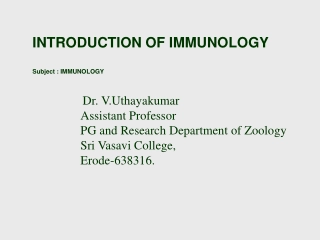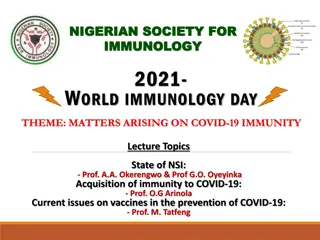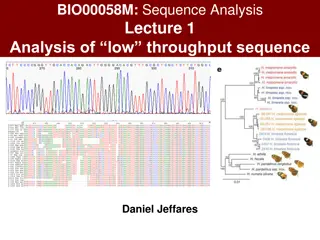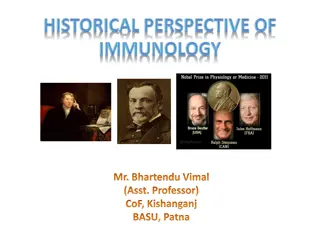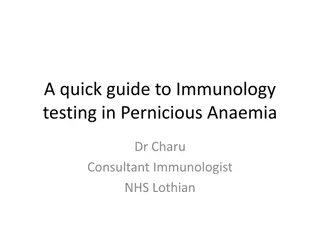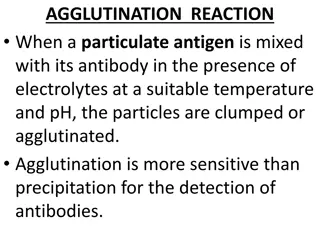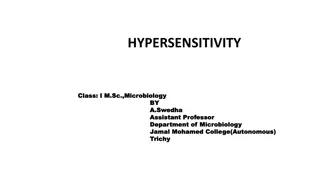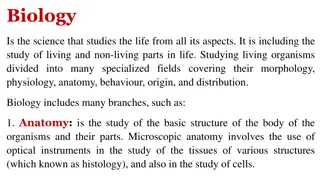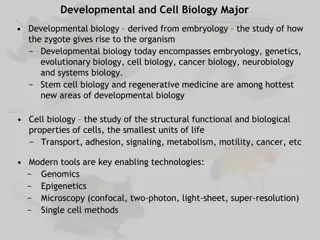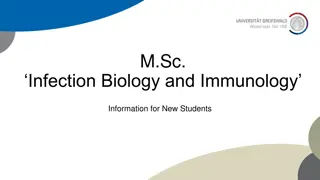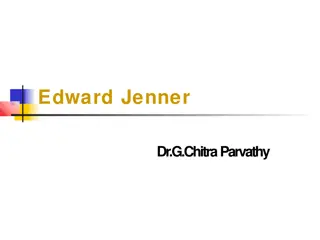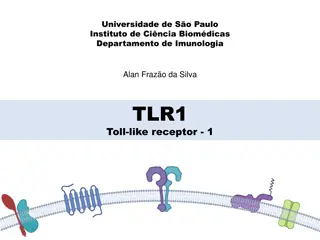
Science Prof Online: Free Science Education Resources
Discover a wealth of free science education resources at Science Prof Online (SPO), including Virtual Science Classrooms, science-related PowerPoints, articles, and images. This valuable website is designed to help students, educators, and science enthusiasts explore various scientific topics. Stay updated with new materials and interactive learning tools available on SPO.
Download Presentation

Please find below an Image/Link to download the presentation.
The content on the website is provided AS IS for your information and personal use only. It may not be sold, licensed, or shared on other websites without obtaining consent from the author. If you encounter any issues during the download, it is possible that the publisher has removed the file from their server.
You are allowed to download the files provided on this website for personal or commercial use, subject to the condition that they are used lawfully. All files are the property of their respective owners.
The content on the website is provided AS IS for your information and personal use only. It may not be sold, licensed, or shared on other websites without obtaining consent from the author.
E N D
Presentation Transcript
About Science Prof Online PowerPoint Resources Science Prof Online (SPO) is a free science education website that provides fully-developed Virtual Science Classrooms, science-related PowerPoints, articles and images. The site is designed to be a helpful resource for students, educators, and anyone interested in learning about science. The SPO Virtual Classrooms offer many educational resources, including practice test questions, review questions, lecture PowerPoints, video tutorials, sample assignments and course syllabi. New materials are continually being developed, so check back frequently, or follow us on Facebook (Science Prof Online) or Twitter (ScienceProfSPO) for updates. Many SPO PowerPoints are available in a variety of formats, such as fully editable PowerPoint files (.ppt), as well as uneditable versions in smaller file sizes, such as PowerPoint Shows (.pps) and Portable Document Format (.pdf), for ease of printing. The font Jokerman is used frequently in titles. It has a microbiology feel to it. If you do not have this font, some titles may appear odd, oversized and off-center. Find free downloads of Jokerman by Googling download jokerman font microsoft . Images used on this resource, and on the SPO website are, wherever possible, credited and linked to their source. Any words underlined and appearing in blue are links that can be clicked on for more information. PPT files must be viewed in slide show mode to use the hyperlinks directly. Several helpful links to fun and interactive learning tools are included throughout the PPT and on the Smart Links slide, near the end of each presentation. You must be in slide show mode to utilize hyperlinks and animations. This digital resource is licensed under Creative Commons Attribution-ShareAlike 3.0: http://creativecommons.org/licenses/by-sa/3.0/ Tami Port, MS Creator of Science Prof Online Chief Executive Nerd Science Prof Online Online Education Resources, LLC info@scienceprofonline.com Alicia Cepaitis, MS Chief Creative Nerd Science Prof Online Online Education Resources, LLC alicia@scienceprofonline.com From the Virtual Microbiology Classroom on ScienceProfOnline.com Image: Compound microscope objectives, T. Port
Immunology Your skin Your Skin pathogen pathogen Your T-cell Images:: Castle, S. Jervis,; Angelina Jolie as assassin in movie Wanted From the Virtual Microbiology Classroom on ScienceProfOnline.com
It Isnt Easy Being a Pathogen Multiple flagella allow H. pylori to penetrate the coating of the stomach epithelium. What a pathogen must do in order to cause disease: 1. Gain access to the body. 2. - Attach to and/or enter cells of its host. - Receptors on pathogen must fit, lock-and-key, with receptor sites on host cell. H. pylori from a gastric biopsy 3. Reproduce while avoiding host s immune system long enough to produce harmful changes. Images: Helicobacter pylori, Yutaka Tsutsumi, M.D; Deep gastric ulcer, Samir; Histopathology of H.pylori from a gastric biopsy, KGH From the Virtual Microbiology Classroom on ScienceProfOnline.com
Normal Flora Protect the body by competing with potential pathogens. This is called microbial antagonism. Normal microbiota protect us by: Consuming nutrients that would otherwise be available to pathogens. Sometimes change the pH of the area they inhabit in ways that help them and hinder competing microbes. Presence stimulates certain parts of the second line of immune defense, helping the body defend itself from invaders. Normal flora of the intestines improve our overall health by producing several types of vitamins. Image: Arm plate of normal flora, T. Port From the Virtual Microbiology Classroom on ScienceProfOnline.com
Innate Immunity First two lines of immune defense considered together. Q: Why do you think that they are called innate immunity? Innate immunity is nonspecific, meaning that these lines of defense work against a wide range of pathogens. Image: Fetus in amniotic sac, National Institutes of Health From the Virtual Microbiology Classroom on ScienceProfOnline.com
First Line of Defense Nonspecific Structures, chemicals, processes that work to prevent pathogens entering the body. Your skin First Line of Defense Includes the skin and mucous membranes of the respiratory, digestive, urinary, and reproductive systems. From the Virtual Microbiology Classroom on ScienceProfOnline.com Images: : Castle, S. Jervis
Skin Physical Components of Defense SKIN Two major layers: 1. epidermis Outer layer composed of multiple layers of tightly packed cells Few pathogens can penetrate these layers Shedding of dead skin cells removes attached microorganisms First Line of Defense Epidermal dendritic cells phagocytize pathogens. These cells extend out among other cells of the epidermis, forming a network to intercept invaders. 2. dermis Contains protein fibers called collagen Give skin strength and pliability to resist abrasions that could introduce microorganisms Image: Skin tattoo, Source unknown; Skin diagram, Daniel de Souza Telles From the Virtual Microbiology Classroom on ScienceProfOnline.com
Skin Chemical Components of Defense perspiration secreted by sweat glands Salt- inhibits growth of pathogen by drawing water from their cells Antimicrobial peptides Lysozyme- destroys cell wall of bacteria First Line of Defense sebumsecreted by sebaceous (oil) glands Helps keep skin pliable and less likely to break or tear Lowers pH of skin to a level inhibitory to many bacteria Images: Cartoon of castle being defended, Source unknown; Hair follicle, Wiki From the Virtual Microbiology Classroom on ScienceProfOnline.com
Mucous Membrane Line all body cavities open to the outside environment. Unlike surface epidermal cells, epithelial cells are living. First Line of Defense Epithelial cells packed tightly to prevent entry of pathogens, but often only one cell layer thick, so pathogens sometimes breech the barrier. Continual shedding of cells carries attached microorganisms away Besides producing mucus, mucous membranes also produce lysozyme and other antimicrobial peptides. OMG U R Nasty > Every day you swallow and digest about 1 liter of mucus. Images: Photo mucous membrane, Source unknown, Drawing of mucous membrane, Gray s Anatomy From the Virtual Microbiology Classroom on ScienceProfOnline.com
Second Line of Defense Nonspecific Operates when pathogens penetrate skin or mucous membranes. Second Line of Defense Cells, antimicrobial chemicals, and processes, but no physical barriers. Many of these components are contained or originate in the blood. Images: Neutrophil bacterial phagocytosis, Uwe Thormann; Ingrown toenail inflammation, Wiki From the Virtual Microbiology Classroom on ScienceProfOnline.com
Formed Elements Three types of formed elements: erythrocytes- red blood cell, carry oxygen & carbon dioxide in the blood. Second Line of Defense platelets - involved in blood clotting (also called thrombocytes). leukocytes - white blood cells; involved in defending the body against invaders. Scanning electron micrograph of formed elements 2 groups Granulocytes Agranulocytes RBC (left) platelet (center) leukocyte (right) Image: Formed elements, NCI-Frederick From the Virtual Microbiology Classroom on ScienceProfOnline.com
Leukocytes>Granulocytes Category of white blood cells characterized by presence of granules in their cytoplasm. 3 types: Neutrophils- Most abundant white blood cell. Predominant cells in pus, accounts for its whitish appearance. Respond quickly following tissue injury. Hallmark of acute inflammation. Second Line of Defense Basophils - Least common granulocyte. When activated, release histamine and other inflammatory chemicals. Eosinophils- Main effecter cells in allergic responses & asthma. Also fight helminth (worm) colonization. Neutrophils and eosinophils can phagocytize pathogens. Image: Neutrophil engulfing Bacillus anthracis, Volker Brinkmann, Photos of granulocytes, Wiki; Drawing of granulocytes, US Gov From the Virtual Microbiology Classroom on ScienceProfOnline.com
Leukocytes > Agranulocytes 2 types: Lymphocytes - most involved in specific immunity (3rd line of immune defense), Second Line of Defense Monocytes- leave the blood and mature into macrophages (phagocytic cells of the second line of defense). Image: Macrophage, Wiki; Lymphocyte, Nicolas Grandjean; Monocyte, Bobjgalindo From the Virtual Microbiology Classroom on ScienceProfOnline.com
Components of the Second Line of Defense Leukocytes - Phagocytosis How phagocytes ingest and destroy foreign matter such as microorganisms or debris. Second Line of Defense - Extracellular killing by leukocytes Nonspecific chemical defenses Phagocytosis of a movie dude. Inflammation Fever From the Virtual Microbiology Classroom on ScienceProfOnline.com
Leukocytes: Phagocytosis Second Line of Defense Let s look at phagocytosis in action! Image: Phagocytosis in three steps & Simple diagram of phagocytosis, Graham Colm From the Virtual Microbiology Classroom on ScienceProfOnline.com
Leukocytes: Extracellular Killing 3 Cell Types That Kill Extracellularly: natural killer lymphocytes (NK cells) Secrete toxins onto surface of virally infected cells & tumors. Differentiate normal body cells because they have membrane proteins similar to the NK cells. Second Line of Defense eosinophils Mainly attack parasitic worms by attaching to their surface. Secrete toxins that weaken or kill worm. Elevated eosinophil levels, is often indicative of a helminth (parasitic worm) infection. neutrophils Can create the active ingredient in bleach to kill nearby microbes. Fibers called neutrophil extracellular traps (NETs) can ensnare and kill bacteria and fungi. Secrete antimicrobial proteins. Image: Natural killer cell (yellow) attacking a cancer cell (red),Dr. Rupert Handgretinger, University Hospital of T bingen; Mouse lung cell NETS engulfing fungus PLoS. From the Virtual Microbiology Classroom on ScienceProfOnline.com
Components of the Second Line of Defense Leukocytes Phagocytosis Extracellular killing by leukocytes Nonspecific chemical defenses - Lysozyme, Defensins & Cytokines (including interferons and interleukins). - Augment phagocytosis Some attack pathogens directly Some enhance features of nonspecific resistance Second Line of Defense Inflammation Fever Images: Interferon molecule, Nevit Dilman, Cytokine network, KUGI, Mouse Clone Database From the Virtual Microbiology Classroom on ScienceProfOnline.com
Components of the Second Line of Defense Leukocytes Phagocytosis Extracellular killing by leukocytes Second Line of Defense - Ex. Lysozyme, Defensins & Cytokines Nonspecific Chemical Defenses Inflammation Nonspecific response to tissue damage. Damages cells release histamines which increase vasodilation. - Heat, swelling, pain Fever From the Virtual Microbiology Classroom on ScienceProfOnline.com Images: Inflamed ingrown toenail, Menetekel
Components of the Second Line of Defense Leukocytes Phagocytosis Extracellular killing by leukocytes Body temp above normal range of 36.5 37.5 C (98 100 F). Second Line of Defense - Ex. Lysozyme, Defensins & Cytokines Nonspecific Chemical Defenses Results when chemicals called ________trigger the hypothalamus to increase body s core temperature. Inflammation Nonspecific response to tissue damage. Damages cells release histamines, which increase vasodilation. - Heat, swelling pain Various types of pyrogens Bacterial toxins Cytoplasm of bacteria released by lysis Antibody-antigen complexes Interleukin-I (IL-1 a cytokine) Benefits Speed of immune system reaction increased Inhibits growth of some temp sensitive microorganisms Fever Images: The sick girl, Michael Ancher From the Virtual Microbiology Classroom on ScienceProfOnline.com
Third Line of Defense Acquired The body s ability to recognize and defend itself against distinct invaders. Is a smart system. Also called specific and adaptive immunity. Third Line of Defense Memory allows it to respond rapidly to additional encounters with a pathogen. - If nonspecific immune system has warriors, then acquired immunity has more sophisticated special agents and assassins. Two types of specific immunity: Naturally acquired = immune response against antigens encountered in daily life. Artificially acquired = response to antigens introduced via vaccine. Q: How does the body recognize invaders? From the Virtual Microbiology Classroom on ScienceProfOnline.com Images: Child getting immunized, PHIL #9423
Antigens Body does not direct immune response against whole bacteria, fungi, protozoa or viruses. Antigens Are Like Name Tags Antigenic particles are often associated with a specific characteristic of an organism, so are detected as foreign when they get inside another organism that doesn t have that characteristic. Foreign molecules trigger a specific immune response. Third Line of Defense Include components of bacterial cell walls, capsules, pili, and flagella, as well as proteins of viruses, fungi and protozoa. Food and dust can also contain antigenic particles. Hi! I m Tami s Cell Enter the body by various methods: Through breaks in skin & mucous membranes Direct injection, as with a bite or needle Through organ transplants and skin grafts Hi! I m Tami s Cell Can I see your I.D.? Images: Blood cells, National Cancer Institute From the Virtual Microbiology Classroom on ScienceProfOnline.com
Antibodies Also called immunoglobulins (Ig). Proteinaceous molecules that bind antigens at the antigen- binding site. Third Line of Defense Considered part of the humoral immune response since bodily fluids such as lymph and blood were once called humors. Images: Antibody, Fvasconcellos From the Virtual Microbiology Classroom on ScienceProfOnline.com
How Antibodies Work Some act as opsonins, markers to identify antigens for phagocytes and stimulate phagoctosis. Some work asantitoxins(i.e. they neutralize toxins for e.g. those causing diphtheria and tetanus). Third Line of Defense Some attach to bacterial flagella making them less active and easier for phagocytes to engulf. Some cause agglutination(clumping together) of bacteria making them less likely to spread Q: But where do antibodies come from? Image: Antigen antibody complex, Dr. Sanderson Immunology Page; Opsonin, Graham Colm From the Virtual Microbiology Classroom on ScienceProfOnline.com
Lymphatic System Screens tissues of the body for foreign antigens. Composed of lymphatic vessels and lymphatic cells. Third Line of Defense One-way system that conducts lymph from local tissues and returns it to the circulatory system. Lymph is a liquid with similar composition to blood plasma. Comes from fluid leaked from blood vessels into surrounding tissues. Lymph nodes house white blood cells called lymphocytesthat recognize and attack foreign antigens present in lymph. Image: Lymphatic system ; The Emirr From the Virtual Microbiology Classroom on ScienceProfOnline.com
Lymphocytes WBCs of specific immunity. Smallest leukocytes. Have huge nucleus surrounded by thin rim of cytoplasm. Produced from blood stem cells in the red bone marrow. Third Line of Defense Two main types: B cellsmature in bone marrow, then concentrate in lymph nodes & spleen. T cellsmature in thymus. B and T cells mature then circulate in the blood and lymph. Circulation ensures they come into contact with pathogens and each other. Image: Lymphocyte SEM; Dr. Triche National Cancer Institute; Lymphocyte, Nicolas Grandjean From the Virtual Microbiology Classroom on ScienceProfOnline.com
T Lymphocytes(T cells) Third Line of Defense: Cell-mediated Immune Response Produced in red bone marrow and mature in thymus. Circulate in the lymph and blood and migrate to the lymph nodes (and other areas of the lymph system). Part of the cellular immune response (aka cell-mediated immune response) because these cells act directly against various antigens Endogenous invaders (intracellular pathogens inside the body s cells) Abnormal body cells such as cancer cells Types cytotoxicorkiller T cells (TC) Destroy compromised body cells helper T cells (TH) Activate B-cells From the Virtual Microbiology Classroom on ScienceProfOnline.com Image: Antigen presentation, Sjef
What Is an Antigen Presenting Cell? Consider your WBCs a security force for your body and any non- self antigens as pictures of a bad guy. The larger the force, the more likely one of the officers will run into a bad guy and help the body apprehend it. Third Line of Defense Any WBC that can grab and present an antigen to another, is called an antigen presenting cell (APC). There are professional (WBC) APC cells, such as B cells, macrophages and dendritic cells. There are also other cells in the body (non-WBCs) that are non-professional APC cells, such as fibroblasts (in skin), some epithelial and endothelial cells & glial cells (in brain). Image: Antigen presentation, Sjef From the Virtual Microbiology Classroom on ScienceProfOnline.com
B Lymphocytes(B cells ) Third Line of Defense: Humoral Immune Response Activated B-lymphocytes produce either: Plasma cells make antibodies to a pathogen. Memory cells remember the same pathogen for faster antibody production in future infections. Image: B cell differentiation, Source unknown From the Virtual Microbiology Classroom on ScienceProfOnline.com
REVIEW! Animated lesson on Humoral Immune Response Image: Antigen antibody complex; Antibody, Fvasconcellos; B cell differentiation, Source unknown From the Virtual Microbiology Classroom on ScienceProfOnline.com
Confused? Here are links to fun resources that further explain acquired immunity: Smart Links Immunology: Innate & Acquired Immunity Main Pageon the Virtual Cell Biology Classroom of Science Prof Online. Phagocytosis animation and quiz by McGraw-Hill. Immune System Who Wants to Be a Millionaire game. Immune System animation and quiz by McGraw-Hill. Fever , song by Peggy Lee & Assassin song by John Mayer Cellular Immune Response & Humoral Immune Response narrated animation and quiz from W. H. Freeman. Immune System Defender, online game from the Nobel Prize website. Use your force of white blood cells to destroy invading bacteria, before they overpopulate and cause disease. Immune System Game, a collection of online fun and educational games about immunology. From the Virtual Microbiology Classroom on ScienceProfOnline.com (You must be in PPT slideshow view to click on links.)
Are microbes intimidating you? Do yourself a favor. Use the Virtual Microbiology Classroom (VMC) ! The VMC is full of resources to help you succeed, including: practice test questions review questions study guides and learning objectives You can access the VMC by going to the Science Prof Online website www.ScienceProfOnline.com Images: White blood cell, Giant Microbes; Prokaryotic cell, Mariana Ruiz

